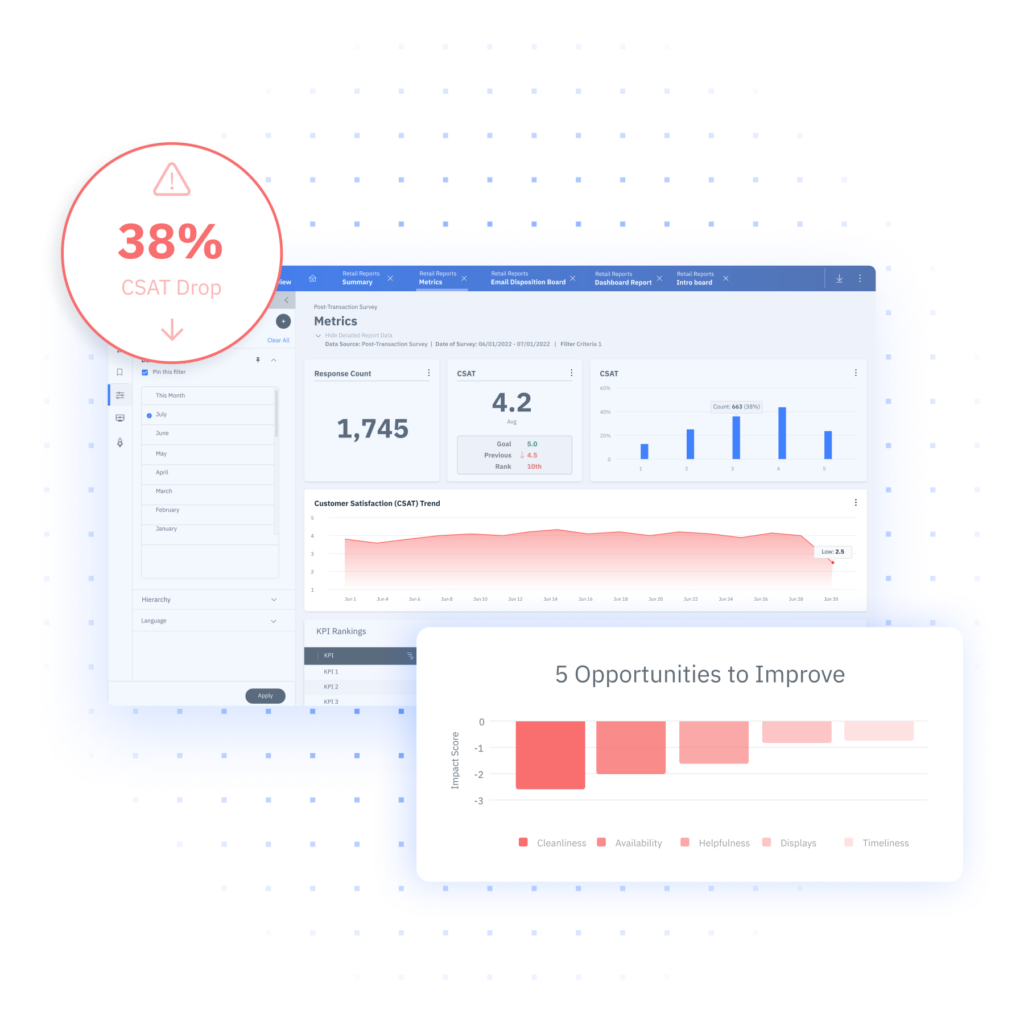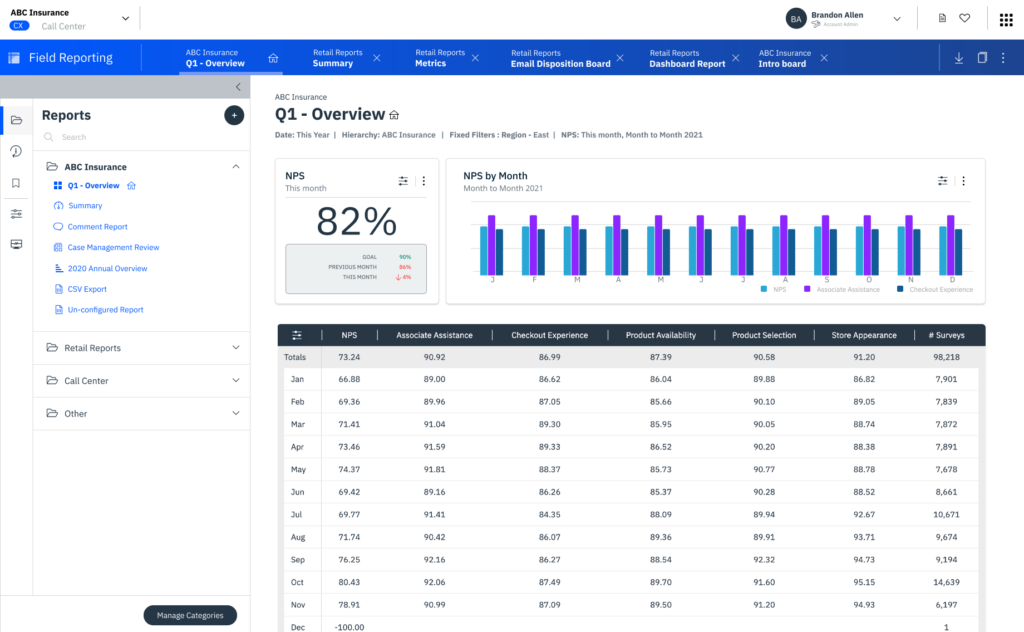Customer Experience: An Overview & How to Start
The customer experience represents every interaction a customer has with your business. Creating, measuring, and maintaining a good customer experience is essential for sustained business success.
Think of your favorite clothing brand. Why is that brand your favorite? It is probably because you enjoy their clothes, but also because every time you buy something it is an easy, enjoyable process. The way you feel about that brand is because of the customer experience you have every time you make a purchase. The customer experience you have with a brand will cause you to be a lifelong customer, or never shop there again.
What is Customer Experience (CX)?
Customer Experience (CX) refers to the overall impression and perception a customer has about a company or brand based on their interactions throughout the entire customer journey. This includes all touchpoints and interactions a customer has with a business, from initial awareness and consideration to purchase, use, and after-sales service.
Customer experience programs refer to an organization’s ongoing efforts to listen to and collect customer feedback, measure customer perceptions of their experiences, and ultimately improve those experiences to encourage positive brand perception and business growth. Customer experience can also be referred to as customer experience management (CXM or CEM).
Why is Customer Experience Important?
Did you know that 86% of consumers are willing to pay more for a product or service if they have a great customer experience? Also, companies who prioritize the customer experience outperform their competitors who do not.
The customer experience represents the relationship that consumers have with your organization. Every interaction a customer has with you is important, and curating a great customer experience shows that you value your customer’s time and feedback, and will use it to further improve your organization.
Focusing on the customer experience will significantly improve your business performance. From increased loyalty and customer lifetime value to decreased churn, the customer experience is key to achieving your goals. Here are some statistics that prove the value of customer experience:
- Organizations focused on customer experience realize revenue 1.7x faster than those who do not
- Customer experience leaders outperform the broader stock market, generating returns that are 108 points higher than the S&P 500 Index
- Customers with positive experiences are likely to spend 140% more than ones with negative experiences
Where to Begin with Customer Experience?
There are a lot of different reasons why you may be looking to improve your customer experience. It might be because organizations that focus on the customer experience are 60% more profitable than those that don’t, or it might be because you are interested in improving customer retention, satisfaction, or lifetime value. Regardless of your goals, there are steps you can take to build a solid foundation for your future customer experience initiatives.
1. Map the Customer Journey
In order to improve the customer experience, you need to make sure you understand the current customer experience that exists in your organization. This can be done by creating a customer journey map. Customer journey mapping is a powerful tool to visualize every touchpoint a customer has with your brand. Customer journey mapping examples can be useful to see how other organizations have visualized their customer experience. This exercise will highlight potential pain points and opportunities to enhance the customer experience.
2. Set Clear CX Goals
Before taking any steps to set up your customer experience program, you will need to meet with the stakeholders within your organization and decide on what you want to achieve. When choosing these goals, try to avoid broad goals such as “improve sales.” Instead, try to make specific, targeted goals such as “improve overall customer satisfaction by 25% over the next year.” Specific goals will help you create a focused strategy, and will also be easier to track success.
3. Design Your CX Program
Now that you have your goals set, you will need to design your CX program. It is important to do this before reaching out to customers via surveys or asking for reviews. That way, when customer feedback does start coming in, you are prepared for it.
These steps will help you create an effective and long-lasting customer experience program. If you want to learn more about the best way to kickstart your CX efforts, check out our beginner’s guide to launching a customer experience program!
How to Measure Customer Experience
There are many different customer experience KPIs on which you can measure the success of your customer experience initiatives. The metrics you choose will depend on what your customer experience goals are. For example. customer satisfaction helps you measure overall satisfaction, while customer effort score measures the ease of which customers interact with your business.
You should choose the metric that most closely aligns to your CX goals. Once you have chosen the metric that makes the most sense, you will need to get a baseline of where your customer experience metrics stand that you can use to measure for improvement. Here is a brief overview of some of the most common customer experience metrics:
1. Customer Satisfaction Score (CSAT)
The customer satisfaction score assesses the overall satisfaction customers feel with your product, service, or overall experience. This score is typically assessed through a customer satisfaction survey that asks “How would you rate your overall satisfaction with the service you received?” where respondents answer on a scale from 1 to 5 or 1 to 10.
This metric is best used for gathering immediate feedback on customer satisfaction with specific aspects of the business. A long-term use case would be to identify areas that need improvement and track changes in satisfaction over time.

2. Net Promoter Score (NPS)
The Net Promoter Score measures customer loyalty and the likelihood of them recommending your brand to others. It involves asking customers a single question: “On a scale of 0 to 10, how likely are you to recommend our product/service to a friend or colleague?” Based on their response, customers are categorized as Promoters (9-10), Passives (7-8), or Detractors (0-6). NPS is calculated by subtracting the percentage of Detractors from the percentage of Promoters.

3. Customer Effort Score (CES)
The Customer Effort Score evaluates how easy it is for customers to interact with your business, whether it’s finding information, getting support, or completing a purchase. Customers are asked to rate the ease of their experience on a scale. A common question is: “How easy was it to resolve your issue with our company?” A lower effort score indicates a smoother, more positive customer experience.
These metrics are important to showing the ROI of your customer experience efforts. They can also be used alongside business growth metrics such as retention rate, repeat purchases, growth in sales, and more to correlate the customer experience improvements with business improvements.
Building a Customer Experience Strategy
A customer experience strategy is a comprehensive plan that outlines how a company intends to improve and manage customers’ interactions and perceptions of its brand. Often headed by a customer experience manager, these plans encompass all touchpoints across the customer journey and aim to deliver a consistent, positive, and memorable experience.
Whether you have an established CX program or are just getting started, a customer experience strategy ensures you are making focused decisions on how to improve the things that matter most to your customers and your business.
If you are just getting started, check out our small CX team checklist to ensure you have everything you need to make the biggest impact to on your customer experience!
Do You Need a Customer Experience Manager?
If your company is new to customer experience, starting with a dedicated customer experience manager is a smart move. This role is crucial for ensuring that all interactions and touchpoints between your company and its customers are positive, consistent, and aligned with your overall CX strategy.
A CX manager serves as the central figure in your customer experience efforts, connecting the dots across different departments—such as frontline employees, sales, marketing, and the executive team. This ensures that the customer experience is cohesive and integrated throughout the organization. Furthermore, a CX manager can lay the groundwork for a strong customer experience strategy and scale the program as your organization grows.
Should You Invest in Customer Experience Management Software?
Customer experience management software is a set of tools that help you manage, analyze, and improve customer interactions across touchpoints throughout the customer journey. The best customer experience management software will be one that fits your business needs, and can be tailored to your specific goals.
Customer experience software can be especially useful for CX managers or small CX teams who do not have the resources available to manually gather and analyze data. By automating the collection and analysis of customer data, customer experience software can quickly identify areas needing improvement and help prioritize them based on potential impact. This means you can focus your efforts on the changes that will make the most difference to your customers.
Customer Experience Examples
A great customer experience can take many forms. But, something that all memorable customer experiences have in common is the ability to put the customer first, no matter what. Here are a few examples of companies that have gone above and beyond to create a customer experience that keeps customers coming back.
Foot Locker
Foot Locker is one of the most popular sportswear companies in the world. As a result, they, deal with a large volume of customer feedback. Going through this customer feedback manually was time-consuming, and caused important feedback to be missed. As a solution, Foot Locker chose text analysis software that allows them to summarize, analyze, and act on the most important comments from customers. In doing so, they increase customer satisfaction and are able to pinpoint any operational changes that need to be made as a solution for future customers.
Yo-Chi
Yo-Chi is one of the most popular dessert spots in Australia. Yo-Chi’s main form of customer feedback is through online reviews. But, with no way to review every review that was coming in, they were struggling to connect with their customers. To fix this problem, they implemented a review management solution that allowed them to tag keywords, analyze sentiment, and respond to reviews. By partnering with InMoment, they were able to realize a 123% increase in Google Profile impressions and improve their clicks to navigation by 92%!
Both of these organizations have created great customer experiences by putting their customers first and making sure they have the necessary tools to listen to and implement feedback in the most efficient way possible.
How to Improve the Customer Experience
Some businesses may think that it takes a lot of effort to improve their customer experience, but the truth is that improving your customer experience can be as simple as updating your business hours, or giving customers a discount on their next purchase for leaving a review. No matter where you are in building your customer experience journey, here are some ways you can improve your customer experience.
Determine what Customers Value Most and Deliver
As you seek to improve your customer experience, gather information on what your current customers value most. You can leverage customer feedback surveys and analyze customer reviews, both good and bad, to determine what your customers are looking for from your company.
Do your customers want your services to be more convenient? Do they want to know more about the service before they buy or subscribe? Do they have concerns about how their information is used and protected? Do they want to spend less time on the phone with customer service representatives?
As you discover what it is that your customers are looking for, take steps to deliver it to them.
Let Customers Know Their Opinions Matter
Tell your customers that you’re listening and making changes to improve their experience. Advertise the changes you are making on your website or through social media. You may also want to thank customers for providing feedback and be quick to address any concerns that they express by reaching out to them personally.
Measure Improvements
As you proceed with your CX improvement strategy, measure the response from your customers with relevant metrics. As you keep track of things like conversions, customer complaints, purchases, and website traffic, you’ll be able to figure out which of your efforts are paying off and which are not.
Consider the Digital Experience
As you work on your customer experience, don’t forget about the digital experience. Making improvements to aspects of the customer experience like your website navigation or automated phone menu options can vastly improve how easily and readily your customers can avail themselves of your services. Convenience and accessibility are large parts of a good customer experience, so be sure not to neglect how technology can help in your overall CX strategy.
Aim for Continuous Improvement
Even as your improvements take effect, build upon your successes by continuing to analyze and improve your customer experience. Don’t rest on your laurels — in today’s constantly changing world of digital commerce, continuous improvement is needed.
This is especially true if your customer’s needs start to outpace your current customer experience model — for instance, you might need greater technology capacity to serve larger numbers of customers, or you might break into a niche market that has different needs.
Improve Your Customer Experience with InMoment
InMomet’s best-in-class XI Platform gives your business all the tools you need to create a great customer experience. You can track the metrics that matter to your business, create cases, respond to customer reviews, and more! Everything within the XI Platform ca be customized for you. Schedule a demo today to see how InMoment can help you improve your customer experience.
References
SuperOffice. 32 CUSTOMER EXPERIENCE STATISTICS YOU NEED TO KNOW FOR 2024. (https://www.superoffice.com/blog/customer-experience-statistics/). Accessed 7/26/2024.
Forbes. 6 Things Customer-Centric Companies Do Differently. (https://www.forbes.com/sites/blakemorgan/2021/08/02/6-things-customer-centric-companies-do-differently/?sh=4c37378165a4). Accessed 8/8/2024.
Forrester. The Business Impact Of Investing In Experience. (https://business.adobe.com/content/dam/dx/us/en/resources/reports/the-business-impact-of-investing-in-experience-forrester-thought-leadership-paper-2021/the-business-impact-of-investing-in-experience-forrester-thought-leadership-paper-2021.pdf). Accessed 8/8/2024.
Watermark Consulting. 2021 Customer Experience ROI Study. (https://watermarkconsult.net/wp-content/uploads/2021/10/Watermark-Consulting-2021-Customer-Experience-ROI-Study.pdf). Accessed 8/8/2024.
Deloitte. The true value of customer experiences. (https://www2.deloitte.com/content/dam/Deloitte/us/Documents/process-and-operations/us-cons-the-true-value-of-customer-experiences.pdf). Accessed 8/8/2024.




